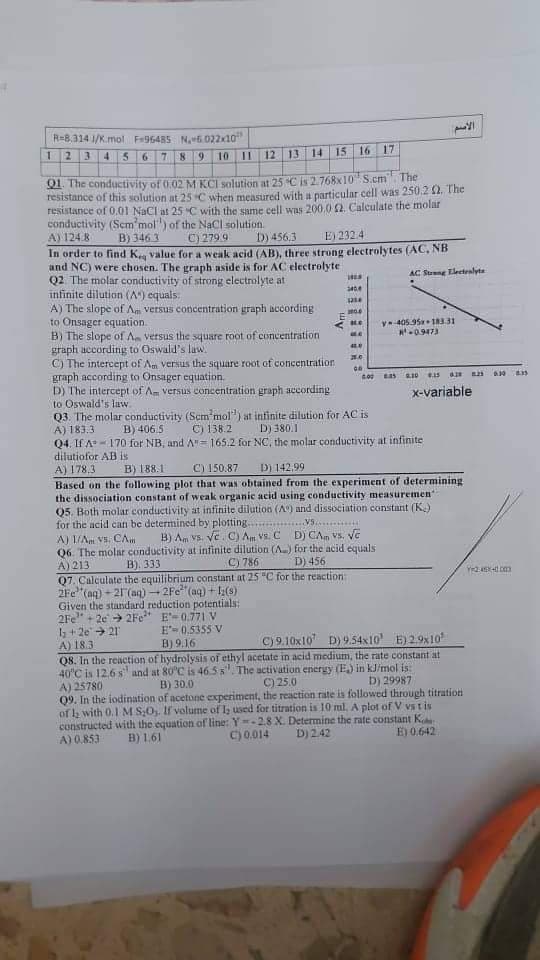Q1. The conductivity of 0.02 M KCI solution at 25 °C is 2.768x10 S.cm The resistance of this solution at 25 C when measured with a particular cell was 250.2 02. The resistance of 0.01 NaCl at 25 C with the same cell was 200.0 12. Calculate the molar E) 232.4 conductivity (Scm'mol) of the NaCl solution. A) 124.8 B) 346 3 C) 279.9 D) 456.3 NR
Q1. The conductivity of 0.02 M KCI solution at 25 °C is 2.768x10 S.cm The resistance of this solution at 25 C when measured with a particular cell was 250.2 02. The resistance of 0.01 NaCl at 25 C with the same cell was 200.0 12. Calculate the molar E) 232.4 conductivity (Scm'mol) of the NaCl solution. A) 124.8 B) 346 3 C) 279.9 D) 456.3 NR
Chapter11: Properties Of Solutions
Section: Chapter Questions
Problem 109AE: Patients undergoing an upper gastrointestinal tract laboratory test are typically given an X-ray...
Related questions
Question
Solve question 1

Transcribed Image Text:R-8,314 1/K.mol F-96485 N, 6.022x10
1 2 345 6 78 9 10 11 12 13 14 15 16 17
Q1. The conductivity of 0.02 M KCl solution at 25 °C is 2.768x10 S.cm The
resistance of this solution at 25 C when measured with a particular cell was 250.2 02. The
resistance of 0.01 NaCl at 25 C with the same cell was 200.0 2. Calculate the molar
conductivity (Sem'mol) of the NaCl solution.
A) 124.8
B) 346 3
C) 279 9
D) 456,3
E) 232.4
In order to find K., value for a weak acid (AB), three strong electrolytes (AC, NB
and NC) were chosen. The graph aside is for AC electrolyte
Q2 The molar conductivity of strong electrolyte at
AC Strong Electrolyte
infinite dilution (A) equals.
A) The slope of Am versus concentration graph according
to Onsager equation.
B) The slope of A versus the square root of concentration
graph according to Oswald's law.
C) The intercept of Am versus the square root of concentration
graph according to Onsager equation.
D) The intercept of A versus concentration graph according
to Oswald's law.
1818
340.4
1214
300.0
BLO
ME
410
30.0
06
6.00
الأسم
v-405.95x 183.31
-0.9473
das
8.10
8.15
x-variable
Q3. The molar conductivity (Sem'mol") at infinite dilution for AC is
A) 183.3
B) 406.5
C) 138.2
D) 380.1
Q4. If A-170 for NB, and A" 165.2 for NC, the molar conductivity at infinite
dilutiofor AB is
A) 178.3
6.10
B) 188.11 C) 150.87 D) 142.99
Based on the following plot that was obtained from the experiment of determining
the dissociation constant of weak organic acid using conductivity measuremen
Q5. Both molar conductivity at infinite dilution (A) and dissociation constant (K₂)
for the acid can be determined by plotting..
VS.....
A) 1/A vs. CAm
B) Am vs. Vc. C) Am Vs. C D) CA, VS. VE
Q6. The molar conductivity at infinite dilution (A) for the acid equals
A) 213
B). 333
C) 786
D) 456
Q7. Calculate the equilibrium constant at 25 "C for the reaction
2Fe (aq) +2 (aq)-2 2Fe²(aq) + 1:(s)
Given the standard reduction potentials:
2Fe +2e2Fe²+ E-0.771 V
1₂ +2e21
A) 18.31
E-0.5355 V
B) 9.3
C) 9.10x10 D) 9.54x10' E) 2.9x10
Q8. In the reaction of hydrolysis of ethyl acetate in acid medium, the rate constant at
40°C is 12,6 s and at 80°C is 46.5 s. The activation energy (E) in kJ/mol is:
C) 25.0
D) 29987
A) 25780
B) 30.0
09. In the iodination of acetone experiment, the reaction rate is followed through titration
of 12 with 0.1 M SO.. If volume of 1₂ used for titration is 10 ml. A plot of V vst is
constructed with the equation of line: Y-2.8 X. Determine the rate constant K
D) 2.42
E) 0.642
A) 0.853
C) 0.014
B) 1.61
0.30
Yes.com
835
Expert Solution
This question has been solved!
Explore an expertly crafted, step-by-step solution for a thorough understanding of key concepts.
Step by step
Solved in 3 steps with 2 images

Knowledge Booster
Learn more about
Need a deep-dive on the concept behind this application? Look no further. Learn more about this topic, chemistry and related others by exploring similar questions and additional content below.Recommended textbooks for you


Chemistry
Chemistry
ISBN:
9781305957404
Author:
Steven S. Zumdahl, Susan A. Zumdahl, Donald J. DeCoste
Publisher:
Cengage Learning

Chemistry: An Atoms First Approach
Chemistry
ISBN:
9781305079243
Author:
Steven S. Zumdahl, Susan A. Zumdahl
Publisher:
Cengage Learning


Chemistry
Chemistry
ISBN:
9781305957404
Author:
Steven S. Zumdahl, Susan A. Zumdahl, Donald J. DeCoste
Publisher:
Cengage Learning

Chemistry: An Atoms First Approach
Chemistry
ISBN:
9781305079243
Author:
Steven S. Zumdahl, Susan A. Zumdahl
Publisher:
Cengage Learning
